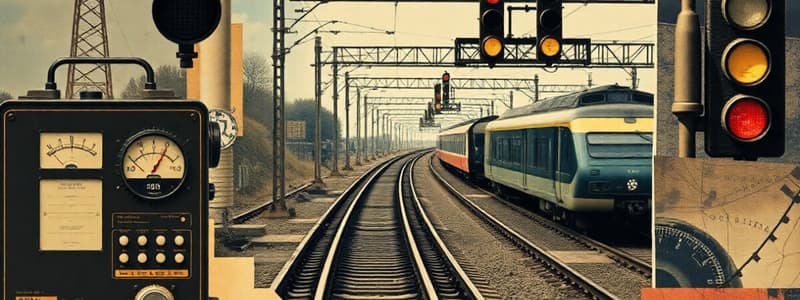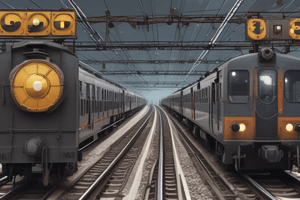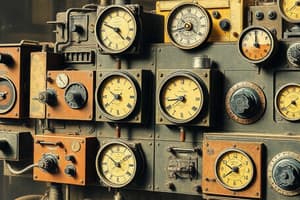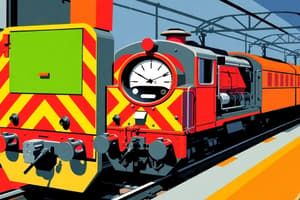Podcast
Questions and Answers
What should not be adopted when seeking and granting Line Clear in suburban and quadruple line sections?
What should not be adopted when seeking and granting Line Clear in suburban and quadruple line sections?
- Use of attention signals
- Repeating signals
- Acknowledging train signals
- Exchange of private numbers (correct)
What does sending the 'Attention Signal' from Station X to Station Z signify?
What does sending the 'Attention Signal' from Station X to Station Z signify?
- A clarification of the bell code
- A request for departure signals
- A notification of a pending train arrival (correct)
- An acknowledgment of Line Clear
How does Station Y acknowledge the 'Is Line Clear' signal?
How does Station Y acknowledge the 'Is Line Clear' signal?
- By sending a new signal
- Through exact repetition on the last beat (correct)
- By discontinuing the signal process
- By turning its Block Instrument to the left
What action follows Station Y's receipt of the last beat of acknowledgment?
What action follows Station Y's receipt of the last beat of acknowledgment?
What signal does Station Z send after the departure of the train from Station Y?
What signal does Station Z send after the departure of the train from Station Y?
What is indicated when the upper needle shows 'Line Clear'?
What is indicated when the upper needle shows 'Line Clear'?
Which part of the double line block instrument indicates the condition of the block section in advance?
Which part of the double line block instrument indicates the condition of the block section in advance?
What does the lower needle indicate when it shows 'Train on Line'?
What does the lower needle indicate when it shows 'Train on Line'?
Who controls the upper needle of the double line block instrument?
Who controls the upper needle of the double line block instrument?
What color segment indicates that the line is closed on the block instrument?
What color segment indicates that the line is closed on the block instrument?
What action alters the indication of the upper needle?
What action alters the indication of the upper needle?
What does the 'Line Closed' indication signify?
What does the 'Line Closed' indication signify?
What is the purpose of Block Bells?
What is the purpose of Block Bells?
What is the first step taken when governing the movement of trains between stations?
What is the first step taken when governing the movement of trains between stations?
What is necessary to confirm that the correct stations are in communication?
What is necessary to confirm that the correct stations are in communication?
What should NOT be adopted when exchanging Private Numbers during Line Clear procedures?
What should NOT be adopted when exchanging Private Numbers during Line Clear procedures?
What signal does Station Y send after receiving the 'Attention Signal' from Station X?
What signal does Station Y send after receiving the 'Attention Signal' from Station X?
How many beats represent the 'Is Line Clear' signal sent by Station Y to Station Z?
How many beats represent the 'Is Line Clear' signal sent by Station Y to Station Z?
What information does Station Z provide to Station Y to confirm Line Clear?
What information does Station Z provide to Station Y to confirm Line Clear?
What operation occurs after Station Z gives the Line Clear?
What operation occurs after Station Z gives the Line Clear?
What is indicated by the Block Instruments showing 'Line Closed'?
What is indicated by the Block Instruments showing 'Line Closed'?
What is the correct procedure after the 'Call Attention' beat has been acknowledged?
What is the correct procedure after the 'Call Attention' beat has been acknowledged?
What does the lower needle of the Block Instrument indicate?
What does the lower needle of the Block Instrument indicate?
Which position indicates that the Block Instrument shows ‘Line Clear’?
Which position indicates that the Block Instrument shows ‘Line Clear’?
Under what condition is the Commutator locked in the ‘Train on Line’ position?
Under what condition is the Commutator locked in the ‘Train on Line’ position?
What should occur immediately after the Bell Code (GR-14.05) is signalled?
What should occur immediately after the Bell Code (GR-14.05) is signalled?
What action must be taken to lock the Commutator in the ‘Train on Line’ position?
What action must be taken to lock the Commutator in the ‘Train on Line’ position?
What happens if the Commutator is turned directly from ‘Line Closed’ to ‘Train on Line’?
What happens if the Commutator is turned directly from ‘Line Closed’ to ‘Train on Line’?
How many positions does the Commutator have?
How many positions does the Commutator have?
What is the primary purpose of the Bell Plunger?
What is the primary purpose of the Bell Plunger?
What is the response to the 'Is Line Clear' signal?
What is the response to the 'Is Line Clear' signal?
When does a station take off the departure signal for the train?
When does a station take off the departure signal for the train?
What action is taken after the train departs?
What action is taken after the train departs?
How is the 'Train entering section' signal acknowledged?
How is the 'Train entering section' signal acknowledged?
What is done after the departure signals are returned to 'ON'?
What is done after the departure signals are returned to 'ON'?
What information is provided when asking for 'Line Clear' on the telephone?
What information is provided when asking for 'Line Clear' on the telephone?
What operation is performed upon sending an 'Attention Signal'?
What operation is performed upon sending an 'Attention Signal'?
How does a station acknowledge the 'Attention Signal' from another station?
How does a station acknowledge the 'Attention Signal' from another station?
What does the station do after acknowledging the 'Train entering section' signal?
What does the station do after acknowledging the 'Train entering section' signal?
What must be done before turning the commutator for 'Line Clear'?
What must be done before turning the commutator for 'Line Clear'?
What is the procedure followed by Station Y upon receipt of the 'Is Line Clear' signal?
What is the procedure followed by Station Y upon receipt of the 'Is Line Clear' signal?
Which step does Station Z perform after receiving the 'Train entering section' signal from Station Y?
Which step does Station Z perform after receiving the 'Train entering section' signal from Station Y?
What does the exact repetition of the acknowledgment signal from Station Y to Station Z represent?
What does the exact repetition of the acknowledgment signal from Station Y to Station Z represent?
What action does Station Z take immediately after acknowledging that the upper needle points to 'Line Clear'?
What action does Station Z take immediately after acknowledging that the upper needle points to 'Line Clear'?
What is indicated if Station Z sends an 'Attention Signal' to Station Y after the train's departure?
What is indicated if Station Z sends an 'Attention Signal' to Station Y after the train's departure?
What does the Normal position of the Commutator indicate?
What does the Normal position of the Commutator indicate?
Which component is responsible for signaling trains using a specific code?
Which component is responsible for signaling trains using a specific code?
Under what condition does the Commutator remain locked in the 'Train on Line' position?
Under what condition does the Commutator remain locked in the 'Train on Line' position?
What happens if the Commutator is turned directly from its normal position to 'Train on Line'?
What happens if the Commutator is turned directly from its normal position to 'Train on Line'?
Which segment color on the Commutator indicates 'Line Clear'?
Which segment color on the Commutator indicates 'Line Clear'?
What specifically triggers the operation of the lower needle of the Block Instrument?
What specifically triggers the operation of the lower needle of the Block Instrument?
What is required before releasing the Bell Plunger?
What is required before releasing the Bell Plunger?
What indication does the Commutator pointer show in the Train on Line position?
What indication does the Commutator pointer show in the Train on Line position?
Which of the following indicates a condition of the Block sections approaching from either direction?
Which of the following indicates a condition of the Block sections approaching from either direction?
Which indication is shown when there is no train in the Block Section and permission has not been granted?
Which indication is shown when there is no train in the Block Section and permission has not been granted?
How does the upper needle's indication differ from the lower needle's indication?
How does the upper needle's indication differ from the lower needle's indication?
What color segment indicates 'Line Clear' on the double line block instrument?
What color segment indicates 'Line Clear' on the double line block instrument?
Which component of the block instrument is primarily operated by the Station Master at the block station?
Which component of the block instrument is primarily operated by the Station Master at the block station?
What occurs when the Commutator is locked in the 'Train on Line' position?
What occurs when the Commutator is locked in the 'Train on Line' position?
Which statement best describes the role of the lower needle on the block instrument?
Which statement best describes the role of the lower needle on the block instrument?
What is the main function of the Bell Plunger within the block instruments?
What is the main function of the Bell Plunger within the block instruments?
What is the purpose of the 'Call Attention' beat before conducting train movements?
What is the purpose of the 'Call Attention' beat before conducting train movements?
What specific action does Station Z take after receiving the 'Line Clear' signal from Station Y?
What specific action does Station Z take after receiving the 'Line Clear' signal from Station Y?
How does Station Y acknowledge the 'Is Line Clear' signal from Station Z?
How does Station Y acknowledge the 'Is Line Clear' signal from Station Z?
What is the correct sequence of communications between Station X and Station Y when governing train movement?
What is the correct sequence of communications between Station X and Station Y when governing train movement?
During the process of seeking 'Line Clear', what must be avoided in suburban and quadruple line sections?
During the process of seeking 'Line Clear', what must be avoided in suburban and quadruple line sections?
Which step is taken immediately after exchanging the names of stations during train movement governance?
Which step is taken immediately after exchanging the names of stations during train movement governance?
What beat sequence is prescribed for sending the 'Is Line Clear' signal?
What beat sequence is prescribed for sending the 'Is Line Clear' signal?
What is the first action taken by Station Y after it receives the 'Attention Signal' from Station X?
What is the first action taken by Station Y after it receives the 'Attention Signal' from Station X?
What should Station Z provide to Station Y to confirm that the train is ready for departure?
What should Station Z provide to Station Y to confirm that the train is ready for departure?
What action is required after Station Y acknowledges the 'Is Line Clear' signal?
What action is required after Station Y acknowledges the 'Is Line Clear' signal?
How does Station Z acknowledge receipt of the 'Train entering section' signal?
How does Station Z acknowledge receipt of the 'Train entering section' signal?
What does Station Y do immediately after the train passes the last stop signal?
What does Station Y do immediately after the train passes the last stop signal?
What does the upper needle of the Block Instrument indicate when it points to 'Line Clear'?
What does the upper needle of the Block Instrument indicate when it points to 'Line Clear'?
What must be done before returning the departure signals to 'ON'?
What must be done before returning the departure signals to 'ON'?
What information does Station Z provide when asking for 'Line Clear' on the telephone?
What information does Station Z provide when asking for 'Line Clear' on the telephone?
What is the primary function of the commutator in the Block Instrument?
What is the primary function of the commutator in the Block Instrument?
How is the factual acknowledgment of the 'Attention Signal' done by Station X?
How is the factual acknowledgment of the 'Attention Signal' done by Station X?
What is the first action that should be taken when asking for 'Line Clear'?
What is the first action that should be taken when asking for 'Line Clear'?
Which signal is sent by Station X after departing the train?
Which signal is sent by Station X after departing the train?
Flashcards
Double Line Block Instrument
Double Line Block Instrument
A three-position lock and block instrument used on Eastern Railway to control train movement in sections of track.
Line Closed
Line Closed
Indicates no train in the block section and no permission given for entry.
Line Clear
Line Clear
Indicates permission for a train to enter the block section.
Train on Line
Train on Line
Signup and view all the flashcards
Upper Needle
Upper Needle
Signup and view all the flashcards
Lower Needle
Lower Needle
Signup and view all the flashcards
Block Section
Block Section
Signup and view all the flashcards
Block Instrument
Block Instrument
Signup and view all the flashcards
Commutator
Commutator
Signup and view all the flashcards
Bell Code
Bell Code
Signup and view all the flashcards
Bell Plunger
Bell Plunger
Signup and view all the flashcards
Suburban and Quadruple Line Sections
Suburban and Quadruple Line Sections
Signup and view all the flashcards
Attention Signal
Attention Signal
Signup and view all the flashcards
Line Clear Signal
Line Clear Signal
Signup and view all the flashcards
Acknowledge Signal
Acknowledge Signal
Signup and view all the flashcards
Departure Signals
Departure Signals
Signup and view all the flashcards
Block Bells
Block Bells
Signup and view all the flashcards
Call Attention Beat
Call Attention Beat
Signup and view all the flashcards
Token or Block Instrument
Token or Block Instrument
Signup and view all the flashcards
Exchanging Station Names
Exchanging Station Names
Signup and view all the flashcards
Private Numbers
Private Numbers
Signup and view all the flashcards
Suburban Sections
Suburban Sections
Signup and view all the flashcards
Block Instrument Shows 'Line Closed'
Block Instrument Shows 'Line Closed'
Signup and view all the flashcards
Block Instrument Shows 'Line Clear'
Block Instrument Shows 'Line Clear'
Signup and view all the flashcards
Train Entering Section Signal
Train Entering Section Signal
Signup and view all the flashcards
What happens when a station master receives a 'Line Clear' signal?
What happens when a station master receives a 'Line Clear' signal?
Signup and view all the flashcards
What are the two main signals a station master sends to the next station?
What are the two main signals a station master sends to the next station?
Signup and view all the flashcards
What are Double Line Block Instruments?
What are Double Line Block Instruments?
Signup and view all the flashcards
What are the three needle indications?
What are the three needle indications?
Signup and view all the flashcards
What's the role of the upper needle?
What's the role of the upper needle?
Signup and view all the flashcards
What's the role of the lower needle?
What's the role of the lower needle?
Signup and view all the flashcards
What does 'Line Closed' mean?
What does 'Line Closed' mean?
Signup and view all the flashcards
What does 'Line Clear' mean?
What does 'Line Clear' mean?
Signup and view all the flashcards
What does 'Train on Line' mean?
What does 'Train on Line' mean?
Signup and view all the flashcards
What does the lower needle indicate?
What does the lower needle indicate?
Signup and view all the flashcards
What does the upper needle indicate?
What does the upper needle indicate?
Signup and view all the flashcards
What is the Commutator's role?
What is the Commutator's role?
Signup and view all the flashcards
Commutator positions: Train on Line
Commutator positions: Train on Line
Signup and view all the flashcards
How does the Commutator unlock?
How does the Commutator unlock?
Signup and view all the flashcards
Purpose of the Bell Plunger
Purpose of the Bell Plunger
Signup and view all the flashcards
Bell Code use
Bell Code use
Signup and view all the flashcards
What is the role of the Bell Code?
What is the role of the Bell Code?
Signup and view all the flashcards
When is the Commutator turned?
When is the Commutator turned?
Signup and view all the flashcards
Why no private numbers?
Why no private numbers?
Signup and view all the flashcards
What is the sequence of operations for clearing a line for a train?
What is the sequence of operations for clearing a line for a train?
Signup and view all the flashcards
What does 'Line Clear' signal mean?
What does 'Line Clear' signal mean?
Signup and view all the flashcards
How does a station master acknowledge a 'Line Clear' signal?
How does a station master acknowledge a 'Line Clear' signal?
Signup and view all the flashcards
What is the 'Train entering section' signal?
What is the 'Train entering section' signal?
Signup and view all the flashcards
What is the 'Attention Signal'?
What is the 'Attention Signal'?
Signup and view all the flashcards
What is the 'Commutator'?
What is the 'Commutator'?
Signup and view all the flashcards
What does a station master do after a train passes their station?
What does a station master do after a train passes their station?
Signup and view all the flashcards
What is the purpose of 'Private Numbers'?
What is the purpose of 'Private Numbers'?
Signup and view all the flashcards
Why is a station master's name given over the phone?
Why is a station master's name given over the phone?
Signup and view all the flashcards
What is the role of the 'Block Instrument'?
What is the role of the 'Block Instrument'?
Signup and view all the flashcards
What is the purpose of line clearance procedures?
What is the purpose of line clearance procedures?
Signup and view all the flashcards
Study Notes
Double Line Electrical Block Instruments
- Instruments used on Eastern Railway are three-position lock and block type
- Various parts and functions are described below
Instrument Parts and Indications
- Needles: Upper and lower needles indicate "Train on Line," "Line Closed," and "Line Clear." Colors used are red, white, and green, respectively, for different segments.
- Commutator: Has three positions (normal, line clear, train on line) indicated on the face using segments
- Normal: Line Closed (white segment), pointer vertical.
- Line Clear: Line Clear (green segment), pointer to the right.
- Train on Line: Train on Line (red segment), Pointer to the left.
- Bell Plunger: Operates a bell at the other end of the block section when pressed.
- Block Bells: Audible signals by means of a code (GR-14.05)
Needle Indications
- Line Closed: No train in the block section and no permission for entry
- Line Clear: Permission for a train to enter the block section has been given
- Train on Line: Block section is occupied by a train
Upper Needle
- Shows the condition of the block section in advance of a train leaving the station
- Controlled by the station master in the immediately preceding block station
- Upper needle's indications correspond with the lower needle of the adjacent instrument
Lower Needle
- Shows the condition of the block section behind a train approaching a station
- Controlled entirely by the station master at the instrument's station
- Lower needle’s indications correspond with the upper needle of the instrument in the rear station
Relation to Block Sections
- Two instruments at each station: one for up direction and one for down direction.
- Lower needles indicate block conditions for trains approaching either direction.
- Upper needles indicate block conditions for trains leaving the station in either direction.
Commutator
- Turns the lower needle of the block instrument, and the upper needle of the instrument at the adjacent cabin.
- Three positions:
- Normal: Line Closed (white segment), pointer vertical
- Line Clear: Line Clear (green segment), right-pointing pointer.
- Train on Line: Train on Line (red segment), left-pointing pointer.
- Locked in "Train on Line" only after a "Line Clear" indication.
- Locked until a train clears the station.
- Turning from normal to "Train on Line" does not lock the commutator.
- Turn commutator after Bell Code has been announced (GR-14.05) and before releasing the Bell Plunger.
Block Bells
- These bells sound a code (GR-14.05)
- Audible signal when used in the prescribed manner
Train Movement Control
- Station-to-station communication via telephone to ensure correct station assignments.
- Exchange of train details and Line Clear confirmations.
- Sequence of signals (Attention Signal, Line Clear, Train entering, Train out, and confirmation) by stations in order.
Studying That Suits You
Use AI to generate personalized quizzes and flashcards to suit your learning preferences.




